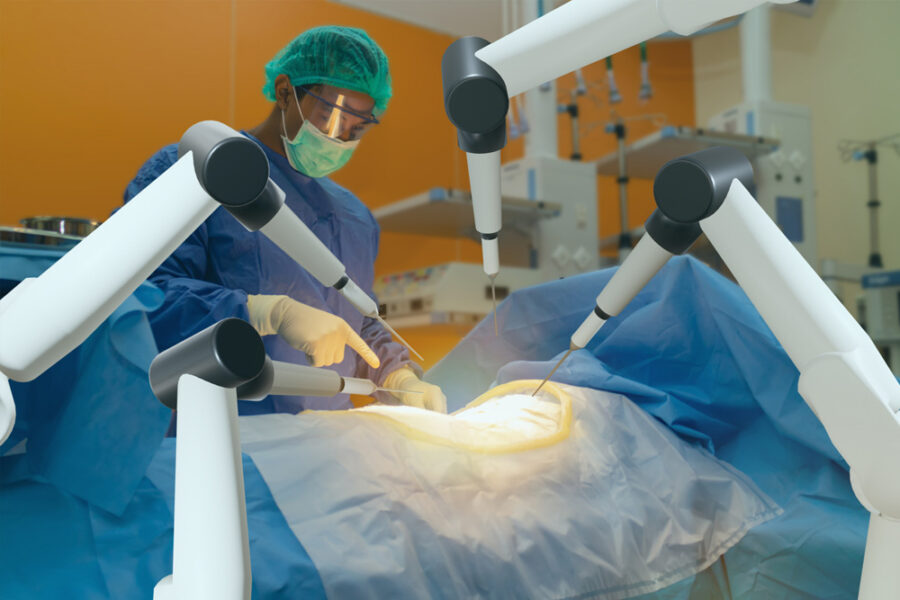 Prostate cancer
Prostate cancer is the cancer of the prostate gland, a walnut-shaped gland
located along the urethra and below the bladder. It is a part of the male
reproductive system. This is a slow-growing cancer and starts to show
symptoms only in advanced stages. This is also one of the reasons why prostate
cancer is primarily diagnosed in men above 65 years old.
Like most other cancers, prostate cancer, too, is harder to cure in advanced
stages. The earlier it is diagnosed, the better the chances of recovery. That’s
why, if you are 50 years or older, it is the perfect time to look out for symptoms
of prostate cancer and understand the risk factors.
For early detection and screening, it is recommended that you consult with a
urologist or an uro-oncologist on an urgent basis.
Symptoms
The most common warning symptoms of prostate cancer are –
- Urinating issues include an urgent need to pee even at night, passing urine
unintentionally, maintaining the flow, failure to empty the bladder, or
urinary incontinence, or experiencing a burning sensation during
urination.
- Pain in the pelvis region, hips, lower back, or chest. The sensation is like
you are sitting on a ball.
- Blood in urine or semen.
- Joint pain or pain in bones could indicate metastasis.
- Erectile dysfunction (ED), like pain during ejaculation, can cause problems
in getting an erection or maintaining it.
Who Is At Risk of Prostate Cancer?
This is the cancer that affects only men. The risks of
prostate cancer increase
with age. However, some men are at higher risk than others. This includes –
- Family history of prostate cancer. If your brother or father has had
prostate cancer, then you are at high risk.
- With age, the risks of prostate cancer increase.
- Men of certain races, like people of African descent, have higher risks of
prostate cancer.
- Specific hereditary cancer syndromes or genetic mutations like BRCA2 or
BRCA1, or Lynch syndrome, may be a risk factor for some men.
- People who smoke regularly are also at risk.
Detection of Prostate Cancer
If you experience any symptoms or belong to the risk group, it is crucial to
consult an onco-urologist as soon as possible. Remember, patients can’t check
themselves for signs of prostate cancer.
The doctor will advise the Prostate-Specific Antigen (PSA) screening test for
cancer. PSA is a natural protein found in the blood of the prostate gland.
Elevated PSA levels in the blood test are an indicator of prostate cancer. But not
all elevated PSA levels mean cancer; it is still a significant indicator. Two other
medical problems where PSA levels are elevated are BPH, or Benign prostatic
hyperplasia, or enlarged prostate, or prostatitis, or an inflamed prostate.
The doctor will, therefore, advise another screening test for prostate cancer
called the digital rectal examination (DRE). In this case, the doctor inserts a
gloved finger into the rectum to check for abnormal growth in the prostate
gland. This is because the rectum is behind the prostate, and this is where
prostate cancerous growth starts to originate.
Importance of Early Detection
The earlier you start the PSA screening test, the better the outcome. Staying up-
to-date on your PSA levels is the best way of knowing if your prostate gland is
healthy or otherwise. The earlier prostate cancer is detected, the better the
chances of recovery and preventing death due to cancer. This is because there
are more treatment options and simpler ones too when prostate cancer is
detected early. Also, as prostate cancer becomes progressive or if it takes more
time to detect the cancer, there are more risks of complications.
It is recommended that you start PSA screening tests as early as possible. As
you turn 50, start making prostate examination a part of your health checkup,
along with blood sugar, blood pressure, and cholesterol.
 Prostate cancer is the cancer of the prostate gland, a walnut-shaped gland
located along the urethra and below the bladder. It is a part of the male
reproductive system. This is a slow-growing cancer and starts to show
symptoms only in advanced stages. This is also one of the reasons why prostate
cancer is primarily diagnosed in men above 65 years old.
Like most other cancers, prostate cancer, too, is harder to cure in advanced
stages. The earlier it is diagnosed, the better the chances of recovery. That’s
why, if you are 50 years or older, it is the perfect time to look out for symptoms
of prostate cancer and understand the risk factors.
For early detection and screening, it is recommended that you consult with a
urologist or an uro-oncologist on an urgent basis.
Prostate cancer is the cancer of the prostate gland, a walnut-shaped gland
located along the urethra and below the bladder. It is a part of the male
reproductive system. This is a slow-growing cancer and starts to show
symptoms only in advanced stages. This is also one of the reasons why prostate
cancer is primarily diagnosed in men above 65 years old.
Like most other cancers, prostate cancer, too, is harder to cure in advanced
stages. The earlier it is diagnosed, the better the chances of recovery. That’s
why, if you are 50 years or older, it is the perfect time to look out for symptoms
of prostate cancer and understand the risk factors.
For early detection and screening, it is recommended that you consult with a
urologist or an uro-oncologist on an urgent basis.



